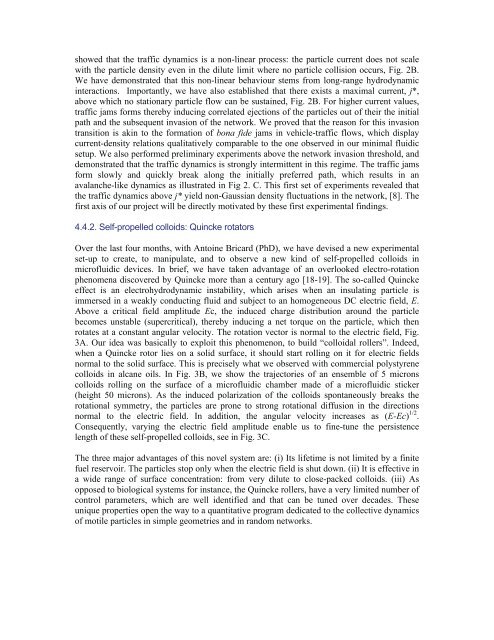Curriculum Vitae - APC - Université Paris Diderot-Paris 7
Curriculum Vitae - APC - Université Paris Diderot-Paris 7
Curriculum Vitae - APC - Université Paris Diderot-Paris 7
Create successful ePaper yourself
Turn your PDF publications into a flip-book with our unique Google optimized e-Paper software.
showed that the traffic dynamics is a non-linear process: the particle current does not scale<br />
with the particle density even in the dilute limit where no particle collision occurs, Fig. 2B.<br />
We have demonstrated that this non-linear behaviour stems from long-range hydrodynamic<br />
interactions. Importantly, we have also established that there exists a maximal current, j*,<br />
above which no stationary particle flow can be sustained, Fig. 2B. For higher current values,<br />
traffic jams forms thereby inducing correlated ejections of the particles out of their the initial<br />
path and the subsequent invasion of the network. We proved that the reason for this invasion<br />
transition is akin to the formation of bona fide jams in vehicle-traffic flows, which display<br />
current-density relations qualitatively comparable to the one observed in our minimal fluidic<br />
setup. We also performed preliminary experiments above the network invasion threshold, and<br />
demonstrated that the traffic dynamics is strongly intermittent in this regime. The traffic jams<br />
form slowly and quickly break along the initially preferred path, which results in an<br />
avalanche-like dynamics as illustrated in Fig 2. C. This first set of experiments revealed that<br />
the traffic dynamics above j* yield non-Gaussian density fluctuations in the network, [8]. The<br />
first axis of our project will be directly motivated by these first experimental findings.<br />
4.4.2. Self-propelled colloids: Quincke rotators<br />
Over the last four months, with Antoine Bricard (PhD), we have devised a new experimental<br />
set-up to create, to manipulate, and to observe a new kind of self-propelled colloids in<br />
microfluidic devices. In brief, we have taken advantage of an overlooked electro-rotation<br />
phenomena discovered by Quincke more than a century ago [18-19]. The so-called Quincke<br />
effect is an electrohydrodynamic instability, which arises when an insulating particle is<br />
immersed in a weakly conducting fluid and subject to an homogeneous DC electric field, E.<br />
Above a critical field amplitude Ec, the induced charge distribution around the particle<br />
becomes unstable (supercritical), thereby inducing a net torque on the particle, which then<br />
rotates at a constant angular velocity. The rotation vector is normal to the electric field, Fig.<br />
3A. Our idea was basically to exploit this phenomenon, to build “colloidal rollers”. Indeed,<br />
when a Quincke rotor lies on a solid surface, it should start rolling on it for electric fields<br />
normal to the solid surface. This is precisely what we observed with commercial polystyrene<br />
colloids in alcane oils. In Fig. 3B, we show the trajectories of an ensemble of 5 microns<br />
colloids rolling on the surface of a microfluidic chamber made of a microfluidic sticker<br />
(height 50 microns). As the induced polarization of the colloids spontaneously breaks the<br />
rotational symmetry, the particles are prone to strong rotational diffusion in the directions<br />
normal to the electric field. In addition, the angular velocity increases as (E-Ec) 1/2 .<br />
Consequently, varying the electric field amplitude enable us to fine-tune the persistence<br />
length of these self-propelled colloids, see in Fig. 3C.<br />
The three major advantages of this novel system are: (i) Its lifetime is not limited by a finite<br />
fuel reservoir. The particles stop only when the electric field is shut down. (ii) It is effective in<br />
a wide range of surface concentration: from very dilute to close-packed colloids. (iii) As<br />
opposed to biological systems for instance, the Quincke rollers, have a very limited number of<br />
control parameters, which are well identified and that can be tuned over decades. These<br />
unique properties open the way to a quantitative program dedicated to the collective dynamics<br />
of motile particles in simple geometries and in random networks.

















